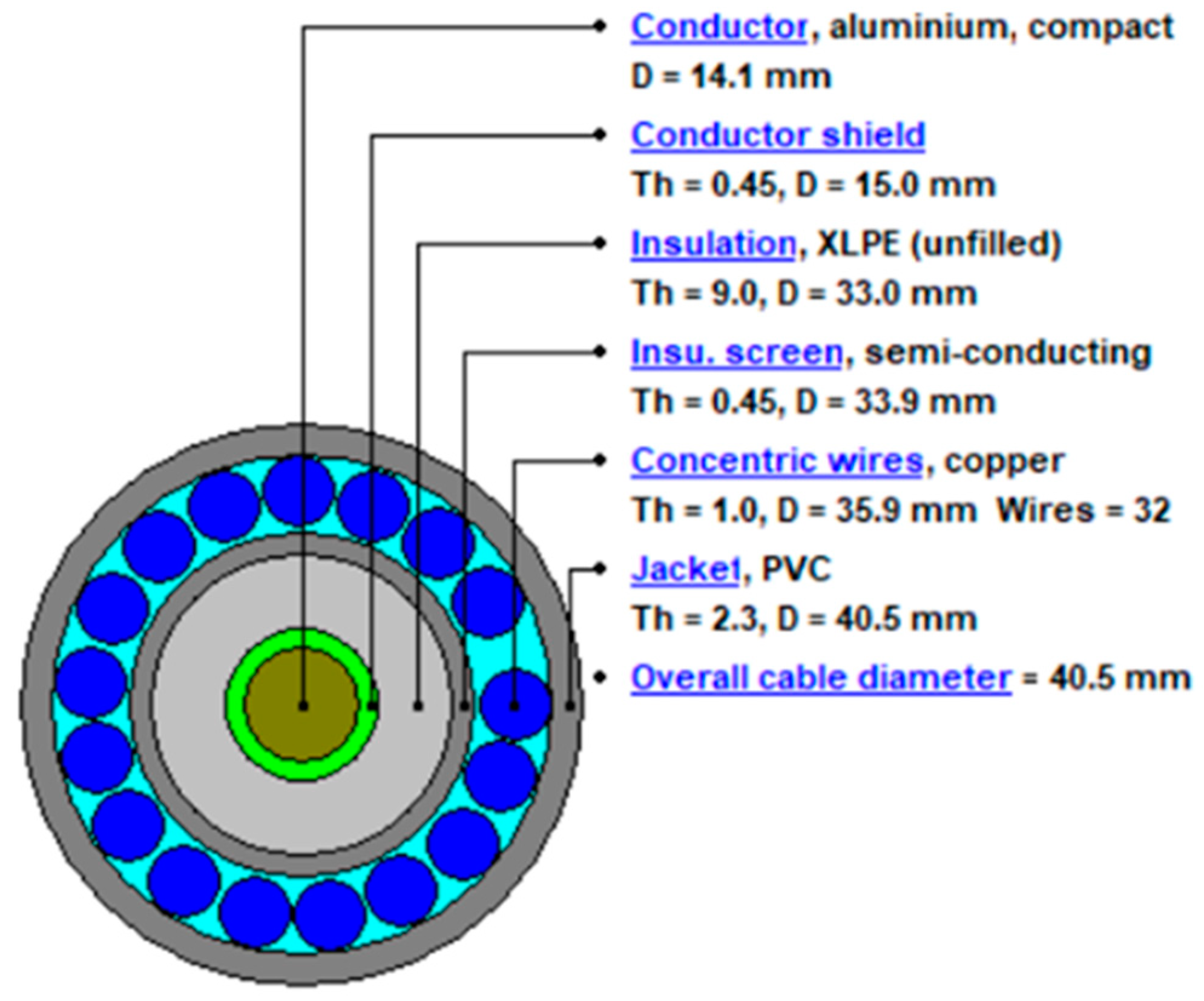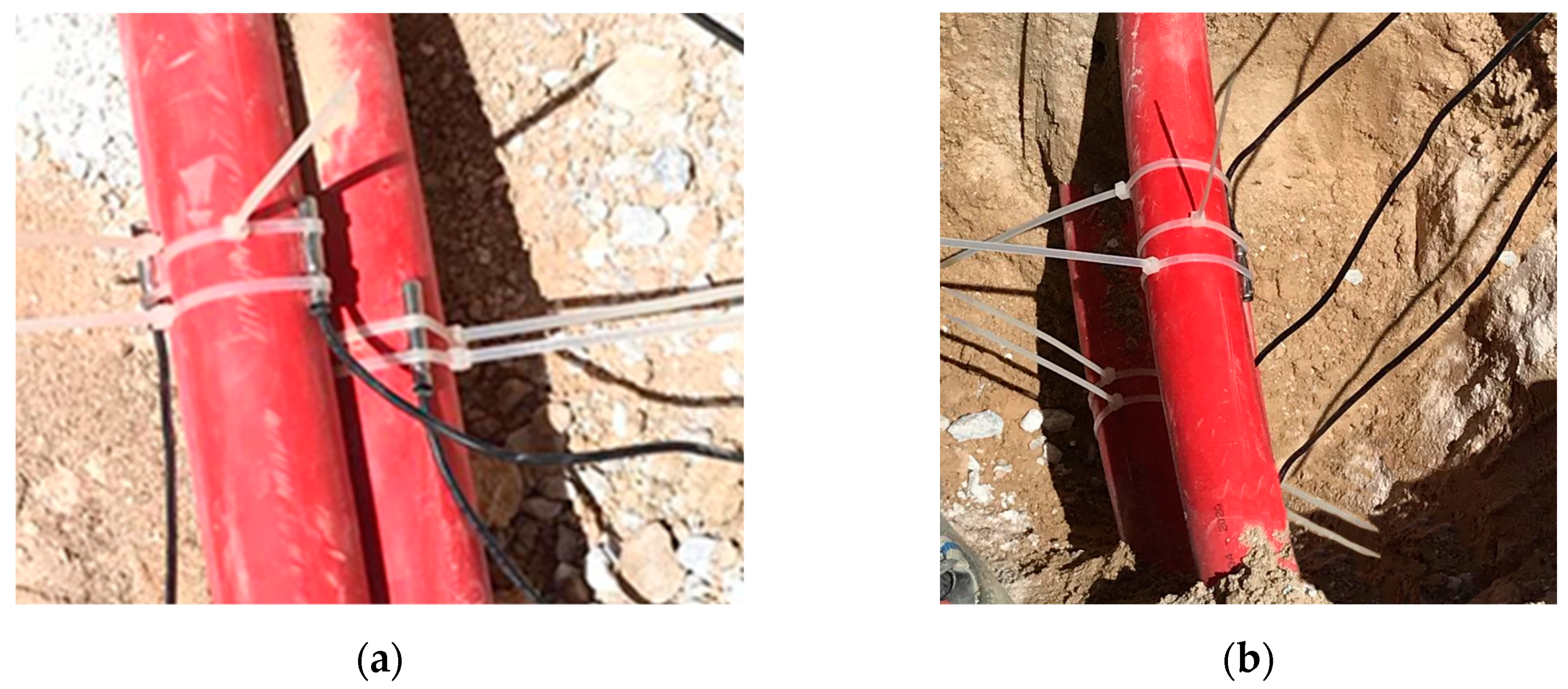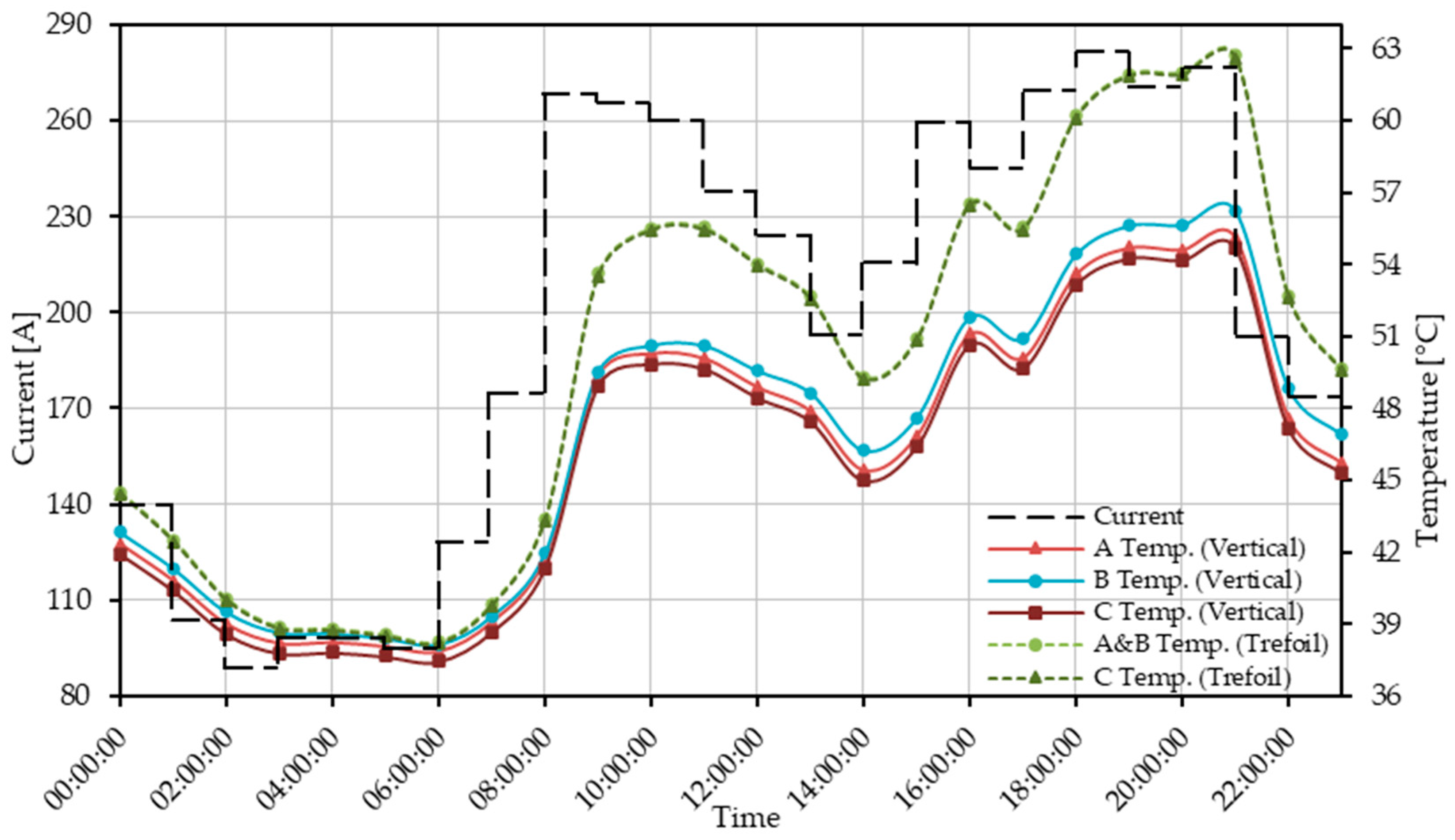The Effect of the Vertical Layout on Underground Cable Current Carrying Capacity
Abstract
:1. Introduction
2. Methodology
2.1. Cable Structure
2.2. Cable Installation Systems
- Burying directly under the ground;
- Tunnel;
- Troughs;
- Duct bank;
- Casing pipe;
- Free air.
2.3. Ampacity Equations
2.4. Cable-Monitoring Techniques
3. Modeling Studies
- According to the IEC 60287 standard, the ambient temperature of soil is assumed to be 20 °C.
- According to the network regulation, the frequency and voltage levels are 50 Hz and 34.5 kV, respectively.
- The cables are grounded at both ends.
- The burial depth is 1 m.
- For vertical and flat layouts, the distance between phases is 7 cm.
- The soil thermal resistance is 1 °C m/W.
4. Field Studies
4.1. Channel Scheme and Excavations
4.2. Measurement System and Data
4.3. Analysis Results
5. Discussion
Author Contributions
Funding
Data Availability Statement
Acknowledgments
Conflicts of Interest
References
- Kara, S.; Alboyacı, B.; Ozyesil, A. Analysis of Armor Grounding Methods in Medium Voltage Underground Power Cables. J. Polytech. 2022, 25, 1587–1594. [Google Scholar] [CrossRef]
- Czapp, S.; Ratkowski, F. Optimization of Thermal Backfill Configurations for Desired High-Voltage Power Cables Ampacity. Energies 2021, 14, 1452. [Google Scholar] [CrossRef]
- Enescu, D.; Colella, P.; Russo, A. Thermal Assessment of Power Cables and Impacts on Cable Current Rating: An Overview. Energies 2020, 13, 5319. [Google Scholar] [CrossRef]
- Masnicki, R.; Mindykowski, J.; Palczynska, B. Experiment-Based Study of Heat Dissipation from the Power Cable in a Casing Pipe. Energies 2022, 15, 4518. [Google Scholar] [CrossRef]
- Brakelmann, H.; Anders, G.J.; Zajac, P. Fundamentals of the Thermal Analysis of Complex Arrangements of Underground Heat Sources. Energies 2021, 14, 6813. [Google Scholar] [CrossRef]
- Zhu, W.; Zhao, Y.; Han, Z.; Wang, X.; Wang, Y.; Liu, G.; Xie, Y.; Zhu, N. Thermal Effect of Different Laying Modes on Cross-Linked Polyethylene (XLPE) Insulation and a New Estimation on Cable Ampacity. Energies 2019, 12, 2994. [Google Scholar] [CrossRef]
- Cywiński, A.; Chwastek, K.; Kusiak, D.; Jabłoński, P. Optimization of Spatial Configuration of Multistrand Cable Lines. Energies 2020, 13, 5923. [Google Scholar] [CrossRef]
- Riba, J.-R.; Llauradó, J. A Model to Calculate the Current–Temperature Relationship of Insulated and Jacketed Cables. Materials 2022, 15, 6814. [Google Scholar] [CrossRef]
- Zhang, Y.; Chen, X.; Zhang, H.; Liu, J.; Zhang, C.; Jiao, J. Analysis on the Temperature Field and the Ampacity of XLPE Submarine HV Cable Based on Electro-Thermal-Flow Multiphysics Coupling Simulation. Polymers 2020, 12, 952. [Google Scholar] [CrossRef]
- Zhu, H.; Han, Z.; Yang, J.; Zhang, R.; Liu, C.; Chen, W.; Cao, Y. Multi-factor simulation analysis of operation characteristics of side-by-side directly buried cables. Electr. Power Syst. Res. 2023, 218, 109143. [Google Scholar] [CrossRef]
- Szczegielniak, T.; Jabłoński, P.; Kusiak, D. Analytical Approach to Current Rating of Three-Phase Power Cable with Round Conductors. Energies 2023, 16, 1821. [Google Scholar] [CrossRef]
- Enescu, D.; Colella, P.; Russo, A.; Porumb, R.F.; Seritan, G.C. Concepts and Methods to Assess the Dynamic Thermal Rating of Underground Power Cables. Energies 2021, 14, 2591. [Google Scholar] [CrossRef]
- Oclon, P.; Rerak, M.; Rao, R.V.; Cisek, P.; Vallati, A.; Jakubek, A.; Rozegnal, B. Multiobjective optimization of underground power cable systems. Energy 2021, 215, 119089. [Google Scholar] [CrossRef]
- WG B1.61. Installation of Underground HV Cable Systems; CIGRE: Paris, France, 2022. [Google Scholar]
- WG B1.44. Guidelines for Safe Work on Cable Systems under Induced Voltages or Currents; CIGRE: Paris, France, 2020. [Google Scholar]
- Holyk, C.; Anders, G.J. Power cable rating calculations—A historical perspective. IEEE Ind. Appl. Mag. 2015, 21, 6–64. [Google Scholar] [CrossRef]
- WG B1.56. Power Cable Rating Examples for Calculation Tool Verification; CIGRE: Paris, France, 2022. [Google Scholar]
- Project and Facility Department. Elektrik Dagitim Sebekeleri Enerji Kablolari Montaj (Uygulama) Usul ve Esaslari; TEDAS: Ankara, Turkey, 2021. [Google Scholar]
- IEC Standard 60287-1:2023; Calculation of the Current Rating, Part 1. International Electrotechnical Commission: Geneva, Switzerland, 2023.
- IEC Standard 60287-2:2023; Calculation of the Current Rating, Part 2. International Electrotechnical Commission: Geneva, Switzerland, 2023.
- Neher, J.H.; McGrath, M.H. The Calculation of the Temperature Rise and Load Capability of Cable Systems. AIEE Trans. Part III Power Appar. Syst. 1957, 76, 752–772. [Google Scholar] [CrossRef]
- WG B1.35. A Guide for Rating Calculations of Insulated Cables; CIGRE: Paris, France, 2015. [Google Scholar]
- Demirol, Y.B.; Kalenderli, O. Investigation of effect of laying and bonding parameters of high-voltage underground cables on thermal and electrical performances by multiphysics FEM analysis. Electr. Power Syst. Res. 2024, 227, 109987. [Google Scholar] [CrossRef]
- Alboyaci, B.; Cinar, M.A.; Demirol, Y.B. Evaluation of cable and busbar system in multiconductor distribution systems interms of current and magnetic field distributions. Turk. J. Electr. Eng. Comput. Sci. 2021, 29, 3119–3132. [Google Scholar] [CrossRef]
- WG B1.45. Thermal Monitoring of Cable Circuits and Grid Operators’ Use of Dynamic Rating Systems; CIGRE: Paris, France, 2019. [Google Scholar]
- IEEE Std 1718-2012; IEEE Guide for Temperature Monitoring of Cable Systems. IEEE: Piscataway, NJ, USA, 2012.
- Fu, C.; Si, W.; Zhu, L.; Liang, Y.; Li, H. Rapid Transfer Matrix-Based Calculation of Steady-State Temperature Rises in Cable Ducts Containing Groups of Three Phase Cable. IEEE Power Energy Technol. Syst. J. 2019, 6, 208–213. [Google Scholar] [CrossRef]















| Cable Layer | Material | Diameter (mm) |
|---|---|---|
| Core | Aluminum | 14.1 |
| Inner semiconductor | Semiconductor | 15.0 |
| Insulation | XLPE | 33.0 |
| Outer semiconductor | Semiconductor | 33.9 |
| Metallic screen | Copper | 35.9 |
| Outer sheath | PVC | 40.5 |
| Layout | Ampacity (A) | Maximum Screen Current (A) | Total Losses of Three Phase (W/m) |
|---|---|---|---|
| Flat | 336.0 | 59.3 | 96.27 |
| Trefoil | 318.0 | 19.9 | 81.61 |
| Vertical | 336.1 | 59.2 | 96.29 |
| Layout | Result Type | Temperature (°C) | ||
|---|---|---|---|---|
| Phase A | Phase B | Phase C | ||
| Trefoil | Measurement | 49.94 | 49.88 | 49.48 |
| Trefoil | Analysis | 49.97 | 49.97 | 49.91 |
| Vertical | Measurement | 43.52 | 46.06 | 44.73 |
| Vertical | Analysis | 43.80 | 45.45 | 44.27 |
Disclaimer/Publisher’s Note: The statements, opinions and data contained in all publications are solely those of the individual author(s) and contributor(s) and not of MDPI and/or the editor(s). MDPI and/or the editor(s) disclaim responsibility for any injury to people or property resulting from any ideas, methods, instructions or products referred to in the content. |
© 2024 by the authors. Licensee MDPI, Basel, Switzerland. This article is an open access article distributed under the terms and conditions of the Creative Commons Attribution (CC BY) license (https://creativecommons.org/licenses/by/4.0/).
Share and Cite
Ozyesil, A.; Altun, B.; Demirol, Y.B.; Alboyaci, B. The Effect of the Vertical Layout on Underground Cable Current Carrying Capacity. Energies 2024, 17, 674. https://doi.org/10.3390/en17030674
Ozyesil A, Altun B, Demirol YB, Alboyaci B. The Effect of the Vertical Layout on Underground Cable Current Carrying Capacity. Energies. 2024; 17(3):674. https://doi.org/10.3390/en17030674
Chicago/Turabian StyleOzyesil, Ahmet, Burak Altun, Yunus Berat Demirol, and Bora Alboyaci. 2024. "The Effect of the Vertical Layout on Underground Cable Current Carrying Capacity" Energies 17, no. 3: 674. https://doi.org/10.3390/en17030674






